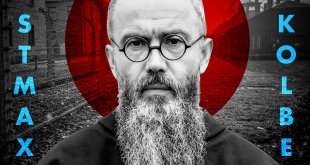Padre Pio was born May 25, 1887 in Pietrelcina, Italy, a small country town located in southern Italy. His parents were Grazio Mario Forgione (1860-1946) and Maria Guiseppa de Nunzio Forgione (1859-1929). He was baptized the next day, in the nearby Castle Church, with the name of his brother, Francesco, who died in early infancy. Other children in the family were an older brother, Michele; three younger sisters: Felicita, Pellegrina and Grazia; and two children who died as infants.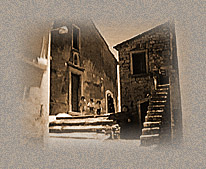
Religion was the center of life for both Pietrelcina and the Forgione family. The town had many celebrations throughout the year in honor of different saints and the bell in the Castle Church was used not for ringing the hour, but for daily devotional time. Friends have described the Forgione family as “the God-is-everything-people” because they attended Daily Mass, prayed the Rosary nightly and fasted three days a week from meat in honor of Our Lady of Mt. Carmel. Although Padre Pio’s grandparents and parents could not read and write, they memorized Sacred Scripture and told the children Bible stories. It was in this lovely family setting that the seeds of Faith were nurtured within Padre Pio.
From his early childhood, it was evident that Padre Pio had a deep piety. When he was five years old, he solemnly consecrated himself to Jesus. He liked to sing hymns, play church and preferred to be by himself where he could read and pray. As an adult, Padre Pio commented that in his younger years he had conversed with Jesus, the Madonna, his guardian angel, and had suffered attacks by the devil.
Padre Pio’s parents first learned of his desire to become a priest in 1897. A young Capuchin friar was canvassing the countryside seeking donations. Padre Pio was drawn to this spiritual man and told his parents, “I want to be a friar… with a beard.” His parents traveled to Morcone, a community thirteen miles north of Pietrelcina, to investigate if the friars would be interested in having their son. The Capuchins were interested, but Padre Pio would need more education than his three years of public schooling.
In order to finance the private tutor needed to educate Padre Pio, his father went to America to find work. During this time, he was confirmed (September 27, 1899), studied with tutors and completed the requirements for entrance into the Capuchin order. At age 15, he took the Habit of the Order of Friars Minor Capuchin on January 22, 1903. On the day of his investiture, he took the name of Pio in honor of Saint Pius V, the patron saint of Pietrelcina, and was called Fra, for brother, until his priestly ordination.
A year later, on January 22, 1904, Fra Pio knelt before the altar and made his First Profession of the Evangelical Counsels of Poverty, Chastity, and Obedience. Then, he traveled by oxcart to the seventeenth-century friary of St. Francis of Assisi and began six years of study for the priesthood and continued his development in community life toward the profession of his solemn vows. After three years of temporary profession, Padre Pio took his final vows in 1907.
Then on August 10, 1910, the much-anticipated day finally arrived. The twenty-three year old Fra Pio was ordained a priest by Archbishop Paolo Schinosi at the Cathedral of Benevento. Four days later, he celebrated his first Mass at the parish church of Our Lady of the Angels.
Within a month of his ordination, (September 7, 1910), as Padre Pio was praying in the Piana Romana, Jesus and Mary appeared to him and gave him the wounds of Christ, the Stigmata. For Padre Pio’s doctors, the wounds created much confusion. He asked Jesus to take away “the annoyance,” adding, ” I do want to suffer, even to die of suffering, but all in secret.” The wounds went away and the supernatural life of Padre Pio remained a secret…for a while.
On November 28, 1911, Padre Agostino, who was a contemporary, friend, and confidant, was advised that Padre Pio was ill. He rushed into Padre Pio’s room to care for him. Padre Agostino observed what he thought was a dying man and rushed to the chapel to pray. When he finished praying, he returned to Padre Pio’s room and found his friend alert and full of joy.
This was the beginning of Padre Pio’s documented ecstasies – all of which were “edifying, theologically correct and expressed a deep love for God. ”
Due to Padre Pio’s on-going ill health, he was sent home to recuperate and was separated from his religious community from the end of 1911 – 1916. During this time, the Capuchin Constitution required a friar who was sent home because of illness had to maintain his friar life as much as possible. Padre Pio did this. He said Mass and taught school.
On September 4, 1916, Padre Pio was ordered to return to his community life and was assigned to San Giovanni Rotondo, an agricultural community, located in the Gargano Mountains. Our Lady Of Grace Capuchin Friary was approximately a mile from town and was not easy to reach. The Capuchins had a reputation for their holiness and simple life. When Padre Pio became a part of the community at Our Lady of Grace, there were seven friars.
With the outbreak of the war, only three friars stayed at Our Lady of Grace; the others were selected for military service. At the beginning, his responsibilities included teaching at the seminary and being the spiritual director of the students. He spent his free time reading the Bible and handling correspondence. When another friar was called into service, Padre Pio became in charge of the college.
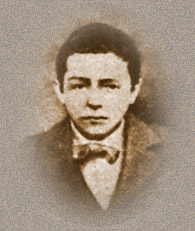 In August 1917 Padre Pio was inducted into the service and assigned to the 4th Platoon of the 100th Company of the Italian Medical Corps. During this time he was very unhappy. By mid-October he was in the hospital, but was not discharged. Finally, in March 1918, he was dismissed and returned to San Giovanni Rotondo.
In August 1917 Padre Pio was inducted into the service and assigned to the 4th Platoon of the 100th Company of the Italian Medical Corps. During this time he was very unhappy. By mid-October he was in the hospital, but was not discharged. Finally, in March 1918, he was dismissed and returned to San Giovanni Rotondo.
Upon his return, Padre Pio became a spiritual director and had many spiritual daughters and sons. He had five rules for spiritual growth: weekly confession, daily Communion, spiritual reading, meditation and examination of conscience. In explaining his spiritual growth rules, Padre Pio compared dusting a room, used or unused on a weekly basis, to weekly confession. He suggested two times of daily meditation and self-examination: in the morning to “prepare for battle” and in the evening to “purify your soul.” Padre Pio’s motto, “Pray, Hope and Don’t Worry” is the synopsis of his application of theology into daily life. A Christian should recognize God in everything, offering everything to Him saying, “Thy will be done”. In addition, all should aspire to heaven and put their trust in Him and not worry about what he is doing, as long as it is done with a desire to please God.
In July 1918, Pope Benedict XV urged all Christians to pray for an end to the World War. On July 27, Padre Pio offered himself as a victim for the end of the war. Days later between August 5 -7, Padre Pio had a vision in which Christ appeared and pierced his side. As a result of this experience, Padre Pio had a physical wound in his side. The experience has been identified as a “transverberation” or piercing of the heart indicating the union of love with God.
A few weeks later, on September 20, 1918, Padre Pio was praying in the choir loft in the Church of Our Lady of Grace, when the same Being who appeared to him on August 5, appeared again. It was the wounded Christ. When the ecstasy ended, Padre Pio had received the Visible Stigmata, the five wounds of Christ, which would stay with him for his remaining 50 years.
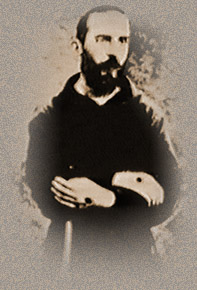 By early 1919, word about the stigmata began to spread to the outside world. Over the years countless people, including physicians, examined Padre Pio’s wounds. Padre Pio was not interested in the physicians’ attempts to explain his stigmata. He accepted it as a gift from God, though he would have preferred to suffer the pains of Christ’s Passion without the world knowing.
By early 1919, word about the stigmata began to spread to the outside world. Over the years countless people, including physicians, examined Padre Pio’s wounds. Padre Pio was not interested in the physicians’ attempts to explain his stigmata. He accepted it as a gift from God, though he would have preferred to suffer the pains of Christ’s Passion without the world knowing.
God used Padre Pio – especially the news of his stigmata – to give people hope as they began to rebuild their life after the war. Padre Pio and his spiritual gifts of the stigmata, perfume, prophecy and bilocation was a sign of God in their midst and led people back to their Faith. So life at the friary and the Church of Our Lady of Grace began to revolve around Padre Pio’s ministry. A room and priests were designated to handle the correspondence and the remaining friars heard confessions. San Giovanni Rotondo began to be filled with pilgrims. Since there were no hotels, people slept outdoors. A normal day for Padre Pio was a busy nineteen hours – Mass, hearing confessions and handling correspondence. He usually had less than two hours to sleep.
As his spiritual influence increased, so did the voices of his detractors. Accusations against Padre Pio poured in to the Holy Office (today the Congregation for the Doctrine of Faith). By June 1922, restrictions were placed on the public’s access to Padre Pio. His daily Mass time varied each day, without announcement to diminish the crowds, and he was ordered not to answer correspondence from people seeking spiritual direction. It was also rumored that plans were being developed to transfer Padre Pio. However, both local and Church authorities were afraid of public riots and decided that a more remote and isolated place than San Giovanni Rotondo could not be found.
Despite the restrictions and controversies, Padre Pio’s ministry continued. From 1924 – 1931 various statements were made by the Holy See that denied the supernaturality of Padre Pio’s phenomena. On June 9, 1931, the Feast of Corpus Christi, Padre Pio was ordered by the Holy See to desist from all activities except the celebration of the Mass, which was to be in private. By early 1933, Pope Pius XI ordered the Holy See to reverse its ban on Padre Pio’s public celebration of Mass, saying, “I have not been badly disposed toward Padre Pio, but I have been badly informed.”
Padre Pio’s faculties were progressively restored. First, the confessions of men were allowed (March 25, 1934) and then women (May 12, 1934). Although he had never been examined for a preaching license, the Capuchin Minister General granted him permission to preach, honoris cuasa, and he preached several times a year. In 1939 when Pope Pius XII was elected pope, he began to encourage people to visit Padre Pio. More and more people began to make pilgrimages.
In 1940, Padre Pio convinced three doctors to move to San Giovanni Rotondo and he announced plans to build a Home to Relieve Suffering. As Padre Pio expressed to Pope Pius, ” …a place that the patient might be led to recognize those working for his cure as God’s helpers, engaged in preparing the way for the intervention of grace.” The doctors were excited about the building, but were fearful that this was not the time to begin such a project with Europe being on the brink of another world war.
These fears did not stop Padre Pio and the project began. After the war, Barbara Ward, a British humanitarian, came to Italy to write an article on postwar reconstruction. She attended Padre Pio’s Mass and met one of the physicians who came to San Giovanni Rotondo to work with the Home to Relieve Suffering. Upon learning of the project, she asked that the Home to Relieve Suffering receive a part of the funds designated for reconstruction. Consequently, the United Nations Relief and Rehabilitation Administration (UNRRA) gave a grant of $325,000 for the project. The building opened its doors on May 5,1956. A year later, Padre Pio announced plans for a medical and religious center where doctors and interns could further their medical studies and Christian formation.
With the opening of the hospital, Padre Pio was truly now an international figure and his followers greatly increased. To accommodate all the pilgrims, a new, large church was constructed.
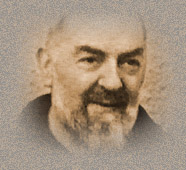 In the mid-1960s, Padre Pio’s health began to deteriorate, but he continued to say Daily Mass and hear fifty confessions a day. By July of 1968, he was almost bedridden. On the fiftieth anniversary of the stigmata (September 20,1968), Padre Pio celebrated Mass, attended the public recitation of the Rosary and Benediction. On the next day, he was too tired to say Mass or hear confessions. On September 22, he managed to say Mass and the attendees had to struggle to hear him. Just after midnight, in the early morning hours of September 23, Padre Pio called his superior and asked to make his confession. He then renewed his vows of poverty, chastity, and obedience. At 2:30am, Padre Pio died in his cell. As he foretold, Padre Pio lived sick but died healthy, with the stigmata healed.
In the mid-1960s, Padre Pio’s health began to deteriorate, but he continued to say Daily Mass and hear fifty confessions a day. By July of 1968, he was almost bedridden. On the fiftieth anniversary of the stigmata (September 20,1968), Padre Pio celebrated Mass, attended the public recitation of the Rosary and Benediction. On the next day, he was too tired to say Mass or hear confessions. On September 22, he managed to say Mass and the attendees had to struggle to hear him. Just after midnight, in the early morning hours of September 23, Padre Pio called his superior and asked to make his confession. He then renewed his vows of poverty, chastity, and obedience. At 2:30am, Padre Pio died in his cell. As he foretold, Padre Pio lived sick but died healthy, with the stigmata healed.
On September 26, 1968, over a hundred thousand people gathered at San Giovanni Rotondo to pay their respects to this holy man. He was buried in the crypt prepared for him in the Church of Our Lady of Grace.


